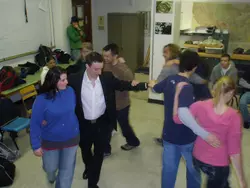Teaching Symmetry Using Kinesthetic Learning--An Exercise Using "Old Time" Dances
David W. Mogk, Montana State University--professor of geology and contra/square dance callerIntroduction
Symmetry is one of the most difficult concepts for students to master in an introductory mineralogy course. It is an abstract concept, and students rarely have had any formal introduction to the subject. Symmetry operations contribute to the "architecture" of crystalline structures by defining the regular, periodic distribution of atoms that lead to the development of three-dimenstional, long-range, ordered crystals. Graphical representations and physical models are typically used to teach symmetry with only marginal success. As an alternative, this module presents a kinesthetic learning approach to demonstrate the dynamic nature of symmetry using "old-time" dancing! You might also want to check out the Dance of Mathematics site, which uses dance elements to demonstrate other mathematical concepts.
In this learning module, students experience symmetry operations by physically doing the movements of the symmetry operations. Each dancer "becomes" an atom in a crystal structure, and physically moves through space to the next positions prescribed by the symmetry operation. Symmetry elements emerge as the dance progresses, and if done successfully, dancers finish at specified locations forming a "perfectly ordered crystal!
What is the purpose of this site?
This site uses the intersection of science and art to demonstrate basic symmetry elements that operate in Nature (and that we emulate in our art forms such as dance, music, painting, architecture). The targeted audience is undergraduate students in an introductory mineralogy course, although the concept of crystal symmetry has broad application in solid state physics, chemistry, biology and material science.
In this module you will find:
- Symmetry Elements--an introduction to the basic symmetry elements that are present in point group symmetry: mirror planes, 2-, 3-, 4- and 6-fold rotation axes, center of symmetry, and the symmetry operations that include translation such as glide planes and screw axes.
- Kinesthetic Learning--an introduction to the theory and practice related to kinesthetic learning as a pedagogic strategy.
- Old-Time Dances--an introduction to the conventions used in "Old-Time" Dance Forms.
- Instructional videotapes of old-time dances that include a) step-by-step walk-throughs showing the dance step and the symmetry it represents, b) a complete demonstration walk-through of each dance, c) the complete dance done to live music, and d) an audiotape of live music and called dances if you want to do these dances in your own class. The dances are:
- Texas Star--an "old-time" square dance showing 4-fold and 2-fold axes, 4-fold screw axis, and center of symmetry.
- Do-si-do and Face the Sides--another "old-time" square dance showing mirrors, 4-fold and 2-fold axes.
- Lady Walpole's Reel--a contra dance showing 2-fold axes, mirrors, center of symmetry, and translation (glide plane).
- Ted's Triplet #7--a triplet dance that shows 2-fold axes, mirrors, center of symmetry and translation.



